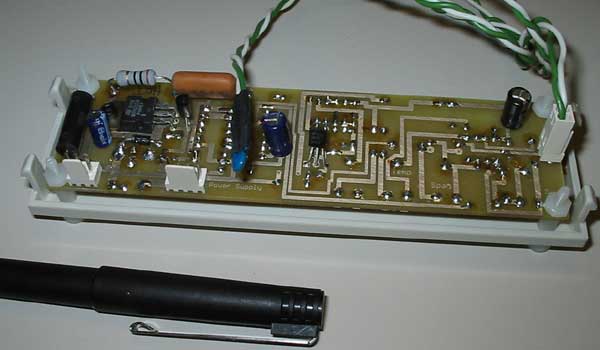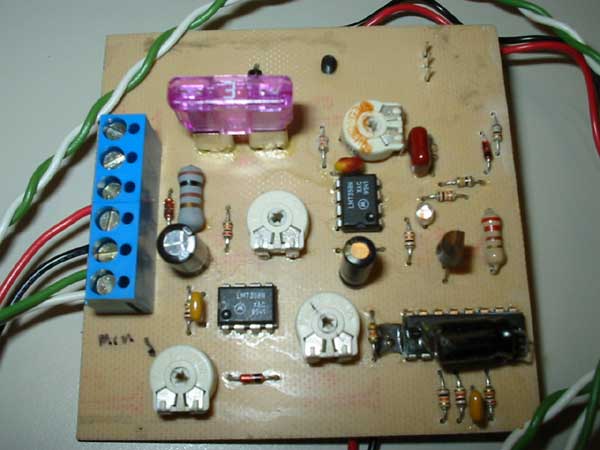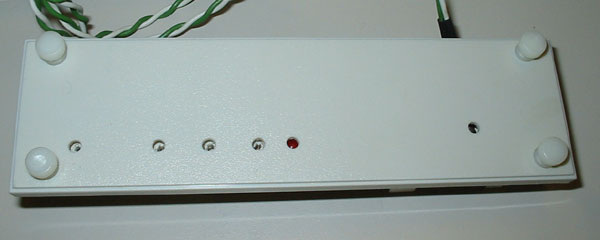|
|
|
|
 Aardils PWM Fan Controller Review Aardils PWM Fan Controller Review
|
|
Date Posted: May 6 2003
|
|
Author: Brians256
|
|
|
|
|
Posting Type: Review
|
|
Category: Thermal Management Reviews
|
|
Page: 1 of 3
|
|
Article Rank:No Rank Yet
Must Log In to Rank This Article
|
|
|
|
|
Note: This is a legacy article, imported from old code. Due to this some items on the page may not function as expected. Links, Colors, and some images may not be set correctly.
|
|
|
Aardils PWM Fan Controller Review By: Brians256
|
|
|
|
|
|
Preview: Aardil's PWM Fan Controller
|
|
|
|
By: Brian S. 5/6/03
|
|
|
|
|
|
This controller was designed for those of us who are tired of pointless noise.
Fast fans are great at removing heat from our overheated overclocked beasts, but they become really annoying when all you need is a quick fix of the Pro/Cooling forums. Modern research has come fairly close to proving you don't need 235 CFM of fan power to browse the web. Thankfully, Aardil has produced a prototype which will run a fan (or set of fans) only as fast as needed. In fact, he has produced two that will be examined in this preview.
For a quick overview of fan control methods, see my earlier article here on fan speed control. Fan speed can be controlled by adjusting DC voltage (7 Volt trick, rheostats, voltage regulators, etc…) or by Pulse Width Modulation (PWM), and Aardil has chosen PWM. PWM is more complex and it has a tendency to cause buzzing with certain fans, but it has the potential to run at much lower speeds than DC voltage control, and it doesn't create several Watts of waste heat at low speeds. Aardil has taken the additional step of using a thermostat to automate PWM fan speed control.
Several products on the market can control your fan speed, but most do not respond to changing conditions. When you are hot and heavy into a FPS game or
creating DivX AVI's, your computer needs more loving from the fans.
That's when you need a fan controller to turn the fans on for you. Why should you have to fiddle with the fan speed knob to keep your system cool? Then, when the CPU is idle such as surfing the web or reading an email, the fan controller should turn your fan down or even turn it off.
This is what Aardil has designed for us: a product that allows the computer to take care of itself. Not only does it save you time and help keep your
computer safe, his latest revision looks quite professional.
|
|
 |
|
|
|
I also had access to an earlier prototype, but it had an issue trying to start large fans.
Actually, it wasn't a prototype of the product as much as it was a test circuit to see if the concept would work.
|
|
 |
|
|
|
Using just enough noise to keep things cool enough is a blessing to many of us. You can see how much Aardil has improved the look from that first circuit.
|
|
 |
|
|
This is the controller's front. This circuit board fits in behind a standard empty drive bay cover and allows the user to adjust the speed and temperature
parameters from the front. See those small holes? Those allow a small screwdriver to adjust pots on the other side of the circuit board.
You can adjust the threshold temperature, the ramp velocity (how aggressively the fan turns on), the temperature span (the temp range over which the fan goes from zero to full velocity), and a setup adjustment to get one of the LED's to turn on when the fan turns on. The two right-most holes expose LED's that tell you (from left to right) when the fan is on and when the whole unit has power.
One feature that is not obvious is that the temperature sensor is not required if you just want to regulate fan speed.
You can remove the thermistor and just adjust the fan speed. However, this makes it an expensive competitor to a rheobus, where the only advantage for Aardil's unit is that it puts out less waste heat (PWM is much more efficient than a variable resistor).
Now, there might not be any displays to tell you the current temperature (such as the Crystal Fontz CF633), but it does the job.
No frills here to empty your wallet. Aardil doesn't want to get into the mod business (as slick as some designs can be) because everyone has their individual style. He and his friend know electronics and how to get the job done, and they'll leave the beautification up to you.
|
|
|
|
Both units are technically prototype units designed to show capabilities and to iron out any problems in the circuit.
So, this preview will not use looks determine acceptability. Aardil provided the prototypes for review but has informed me that a final version will be available within a couple of weeks. It will include some improvements such as improved efficiency (less waste heat) and a cleaner signal going to the fan. As an interesting side note, Aardil was not the actual circuit designer for the controller. Aardil has an unnamed buddy who does this sort of stuff for a living and volunteered to help us cooling geeks. From current impressions, what we get is an industrial strength product for dirt cheap!
|
|
|
|
|
Feature
|
Prototype Specification
|
|
Price
|
$39 + Shipping
|
|
Channels
|
1
|
|
Max rated amperage
|
5A
|
|
Minimum fan speed
|
0%
|
|
Maximum fan speed
|
100%*
|
|
|
|
|
The prototype as shipped is not necessarily what will be mass produced. However, the feature set seems to be firm, as the second prototype contains the
actual PCB layout intended for mass production. The planned improvements are simply cosmetic.
The theoretical maximum speed of the controller is 100%, but the first prototype actually runs the fan closer to 80% when fully engaged.
The second prototype can run much closer to 100%. With any circuit, there will be some voltage drop, but this board drops about 0.6V (typical of a power MOSFET)so it runs quite close to full speed when required.
The maximum rated amperage of the prototype (in my estimation) is five amps, but that is only because of the width of the PCB traces (there will be more on this
subject later). The PCB traces can handle more current with more heat dissipation and with more voltage drop, but it really should not be an issue.
The second prototype has a five amp fuse to keep anything from drawing too much current and burning up the board, but it can handle more than that in a pinch. Just be careful if you control multiple fans with it. Both prototypes run well with five 120mm fans, and if you need more than that you probably aren't interested in quiet operation!
As you can see, the only major limitation is that the fan controller only has one fan connection. Obviously, that does not mean that it can only control
one fan. What it does mean is that all connected fans will run at the same proportional speed. Is that a failing? Actually it may be a benefit for most of your fans.
When cooling a system, there are two kinds of fans: airflow fans and air turbulence fans. Air flow fans move are into or out of the computer case, while
air turbulence fans create better heat transfer between case air and some hot component. An inlet fan is an example of an airflow fan, and a CPU heatsink fan would be an example of a turbulence creating fan. Of
course, these categories are not distinct.
A PSU fan moves hot air out of the computer case (in the ATX design style), but it also creates significant turbulence running over the MOSFET heatsinks in your PSU. As another example, consider the fan used on the nVidia 5800 Ultra. The nVidia reference design for the NV30 moves high velocity air over the GPU heatsink to absorb heat and it also moves the newly heated air out of the case.
For airflow fans, typical designs balance input and output so that no more air is being pulled into the case than is being pushed out. If Aardil's fan
controller was used to control only output fans, then the case pressure would rise as the output fans decreased their speed. That doesn't make much sense, though.
If you want to reduce airflow, reduce both the input fans and the output fans at the same rate. However, it gets more complicated.
Consider an air turbulence fan such as a 40mm fan on a GPU versus the monster 120mm exhaust fan on a heater core.
Reducing the power to 60% on the exhaust fan might increase your CPU temperature by 5°C, but the GPU could get cooked! The CFM moved by a fan may be linear (see here), but the GPU might not be able to handle 40% less cooling. At 12V, a 50mm GPU fan might move 4-6 CFM, but dropping fan voltage to 5-6V might let the GPU fry.
It's all about how much safety margin you have, and airflow fans typically have more margin than the turbulence fans. Reducing case flow by 50% is not nearly as dangerous as reducing the airflow over a CPU by 50%.
With the single channel, I control my heater core fans with Aardil's controller and leave the PSU and GPU fans at full speed. There are no inlet fans on
my systems as I rely upon multiple passive inlet points for air coming into the case, but if I had any other case fans, they would hook into the PWM controller as well.
|
|
Due to the limitations of my testing setup, not a lot of useful numerical testing could be done on this unit. There are three categories of tests that I
rejected: those that I cannot do because of equipment limitations, those that destroy the prototype or other equipment, and those that have no real value.
I also do not have the ability to accurately measure fan output in CFM, although this could be extrapolated from duty cycles. Nor do I have the ability to
measure actual noise output.
I would dearly love to say that a fan controller can reduce noise by an actual percentage number, or even that it lowered it to a certain decibel level. Unfortunately, you will have to put up with subjective results on the noise level. The results will range from "Can't Hear It" to "Really Loud and My Wife is Upset Now" levels. I thought about buying a cheap sound level measurement tool from Radio Shack™, but it might give misleading results. Actual professional sound measurements are done in controlled conditions with sound proofed rooms and with measurements taken at precise distances and angles. Since I do not have a room to dedicate to sound measurements, you will have to live with the "Can't Hear It" and "Louder Than My Sparkle 400W PSU" style of observations. Thankfully, fan noise never reached "Loud As My Baby Screaming for a Bottle" levels.
I am unwilling to perform destructive tests upon the prototype in the case that Aardil wishes to have the units returned. This, unfortunately, rules out
any real determination of actual maximums (number and size of fans, operating temperatures, etc…). I can and will analyze the prototype for theoretical load maximum based upon circuit trace width and component values.
I will also verify that the adjustments are flexible enough to handle certain temperatures. After all, not all of us use the same cooling technology. Some of us use air cooling for 40˚C to 70˚C temperatures. Some of us use watercooling for 30˚C to 50˚C temperatures. Finally, some of us use the RealMan™ cooling technologies (peltiers and/or phase change cooling) for temperatures reaching as low as -50˚C on the cool side and possible hot-side temperatures up to 80˚C.
|
|
|
|
|
|
|
|
|
|
Evaluation Criteria
|
|
A fan controller is good or bad depending upon how well it manages your cooling system. Is it easy to use? Does it handle all your fans?
Does it react quickly enough to changing load requirements? Does it fail in an appropriate way? Does it cost too much? I'll try to cover each of those areas.
|
|
|
|
First Impressions
 |
|
|
|
|
| Random Forum Pic |
 |
| From Thread: 0221 casemodding, first steps (56K, beware) |
|
| | ProCooling Poll: |
| So why the hell not? |
|
I agree!
|
 67% 67%
|
|
What?
|
 17% 17%
|
|
Hell NO!
|
 0% 0%
|
|
Worst Poll Ever.
|
 17% 17%
|
Total Votes:18Please Login to Vote!
|
|






 Aardils PWM Fan Controller Review
Aardils PWM Fan Controller Review


